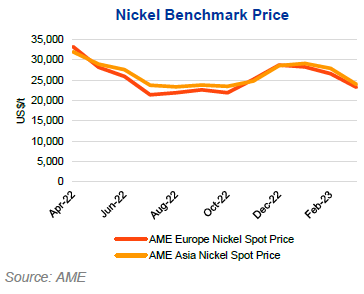The European spot price of nickel forecast in the June quarter has been revised down to US$23,000/t from US$26,000/t, following increased liquidity on the LME as Asian trading hours resumed.
This will lead to a lower annual price of
US$23,615/t in 2023, down from the previous forecast of US$25,875/t. The
finished nickel market is expected to remain in surplus, with 215kt of
oversupply from expanding Indonesian operations.
LME Nickel market confidence was dealt
another blow in March, when it was discovered that 54t of nickel deliveries
from Access World Rotterdam, an LME approved warehouse, were in fact bags of
stone. The delivery, totalling nine warrants, is worth an estimated US$1.3m.
All remaining LME warehouses were instructed to inspect and weigh their metal,
no further anomalies have been found. The incident is believed to be an
isolated case but the possibility of false deliveries under LME’s watch has led
to further market unease.
The LME’s precise grade requirement of
class 1 nickel deliveries continue to disrupt the relationship between prices
and production, as the majority of global supply is dominated by lower-grade,
or class 2 products. In light of this, the exchange has proposed a series of
changes to revive its nickel contracts and reclaim its role as the benchmark
price setter of the metal.
Changes that will immediately be
implemented include a hard 15% daily price limit, which will be permanently
imposed on all metals. The waiting time for class 1 nickel brand applications
has been shortened from nine to three months. Further assessment studies and
frameworks will be conducted to strengthen risk controls. Measures will also be
taken to increase liquidity on its electronic trading platform.
The exchange is also considering the
possibility of accepting class 1 coarse powder deliveries to capture the
battery sector within the year, and to review its membership requirement of LME
Clear to include stronger credit monitoring. A class 2 contracts trading
platform may be introduced alongside LME Nickel. Additionally, the LME may
partner with its affiliate Qianhai Mercantile Exchange (QME), to open a trading
platform for nickel sulphate and matte.
The EU has added battery-grade nickel as
a strategic raw material for the energy transition, in line with its Critical
Raw Materials Act. This means that the bloc will prioritise the development of
nickel mining and processing projects by expediting the permitting and funding
stages. Difficulties associated with sourcing the metal were also identified,
including the privatisation of available supply contracts and a strong reliance
on imports. Approximately 29% of the EU’s finished nickel is sourced from
Russia, followed by Finland (18%), Norway (11%) and Canada (7%).
In Canda, Flying Nickel Mining has signed an Impact and Benefit
Agreement with Norway House Cree Nation (NHCN) for the development of the
Minago Project. NHCN will receive employment, contract opportunities, and a
percentage of revenues received. A joint venture may also be established for
the sale of dolomitic limestone and granitic rock, waste materials that are
often used in the production of cement and construction.

